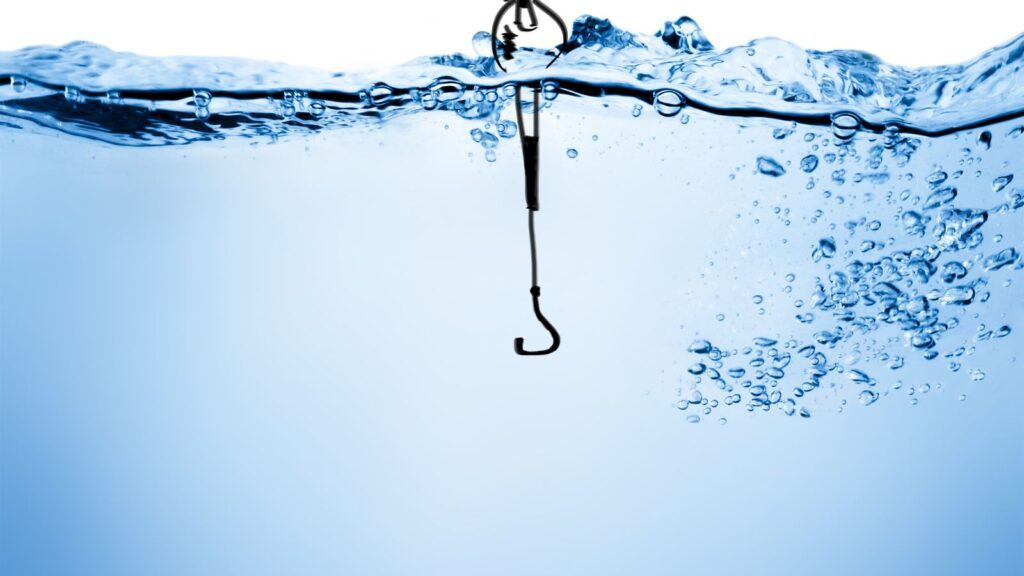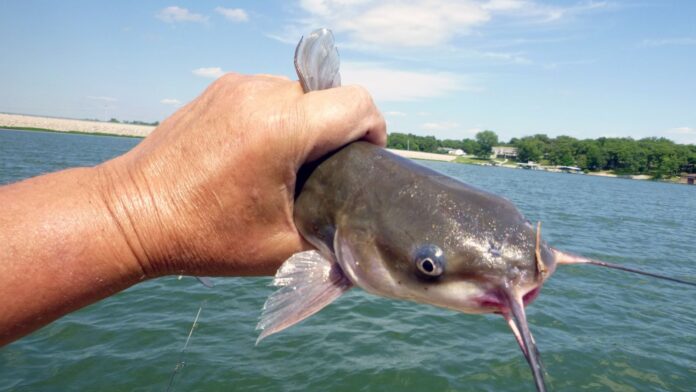Welcome to the exciting world of jug fishing for catfish! In this comprehensive guide, we will delve into the ins and outs of this age-old angling technique, often overlooked but brimming with potential for fun and plentiful catches.
From bait selection to tips on locations and setting up your gear, “Mastering the Art of Jug Fishing for Catfish: Tips, Baits and Techniques” has you covered.
Key Takeaways
- Jug fishing for catfish is an effective and enjoyable way to catch multiple fish without much hassle.
- To set up for jug fishing, secure the jug or float properly and set the right depth and distance between jugs.
- Live baits such as worms, crickets, minnows, fresh cut bait like shad can be used effectively to attract catfish while dead baits like chicken liver also works fine in attracting catfish.
- By choosing the appropriate equipment such as suitable containers (jugs), preparing strong knots, selecting best baits with patience and constant monitoring of the jugs will lead you to master this unique technique that relies on strategic placement within prime underwater habitats where your targets frequent – such as near structure or heavy cover frequented by big cats seeking refuge from predators or hunting prey themselves.
Understanding Jug Fishing For Catfish
Jug fishing for catfish involves using plastic jugs or floating devices as stationary lines with baited hooks attached.
Definition And Purpose
Jug fishing, also known as noodling or float fishing, is an effective and enjoyable way to catch catfish. The main purpose of this technique is to maximize the number of lines in the water by utilizing jugs as floats instead of traditional rods and reels.
This method allows anglers easy control over multiple fishing lines without much hassle and offers increased chances of landing a catch.
The foundation for successful jug fishing lies in selecting appropriate equipment such as suitable containers (jugs), preparing strong knots, attaching hooks with various baits, and setting the correct depth according to your chosen body of water.
A simple setup consists of attaching your line to a jug or another floating device before securing it with baited hooks at regular intervals along the submerged section.
Types Of Water Bodies Suitable For Jug Fishing
Jug fishing for catfish is suitable for a variety of water bodies, including rivers, lakes, and ponds. However, it’s important to note that jug fishing is most effective in slow-moving or still waters where the current isn’t strong enough to move your jugs around too much.
For example, small creeks or streams may not be ideal locations for jug fishing since currents can quickly carry the jugs downstream. On the other hand, larger lakes with calm waters are perfect spots for setting up a few jugs and waiting for the fish to bite.
In fact, many anglers consider large reservoirs as prime locations to use this technique due to their size and potential abundance of catfish.
Equipment And Gear Needed
As for equipment and gear needed to start jug fishing for catfish, you’ll need jugs or noodles (plastic containers with a hole in the top for your line), fishing lines, hooks, weights, bait, and some way to secure the floating container.
You can make homemade versions of these with soda bottles and pool noodles if you’re on a budget. It’s also important to consider proper safety gear like life vests and sun protection when spending time out on the water.
Best Baits For Jug Fishing
Live baits such as shad, bluegill, and worms are a great option for jug fishing catfish.
Live Baits
Live baits are some of the most effective options when jug fishing for catfish. These include worms, crickets, and minnows. When using live bait, hook them gently and make sure they’re secure to prevent them from falling off too soon.
Consider the size of the bait compared to the fish you’re targeting; smaller fish may prefer a smaller meal while larger ones may go for larger bait.
Another great option is using fresh cut bait like shad or skipjack herring. These oily baits can create a strong scent trail in the water which helps attract nearby catfish towards your jugs.
By selecting the right live baits for your target species and conditions, you can significantly increase your chances of catching big cats while jug fishing!
Dead Baits
Using dead baits for jug fishing can be an effective way to attract catfish. Some popular options include chicken liver, shrimp, and cut bait. When using dead bait, it’s important to ensure that it’s fresh and hasn’t gone bad as this could turn off the fish.
Another tip is to use a treble hook with your dead bait to increase your chances of hooking a catfish. Keep in mind that different types of catfish may prefer certain types of dead baits over others so it may take some trial and error before you find what works best for the body of water you’re fishing in.
Artificial Baits
Artificial baits can be a great option for jug fishing catfish. These baits are typically made of plastic and come in various shapes, sizes, and colors to imitate live bait.
Some popular artificial baits for catfishing include curly tail grubs, swimbaits, and soft plastic worms.
When selecting an artificial bait for jug fishing catfish, it’s important to consider the type of water you’re fishing in and the behavior of the target fish species. If you’re fishing in murky waters with low visibility, brighter colored lures may be more effective at grabbing the attention of passing fish.
Overall, incorporating artificial baits into your jug fishing repertoire can expand your options while out on the water.
Setting Up For Jug Fishing
To set up for jug fishing, you’ll need to find the perfect location, secure the jug or float, and set the depth and distance of your line.
Finding The Perfect Location
To find the perfect location for jug fishing, it’s important to consider the type of water body you’ll be fishing in. Look for areas with slow-moving water or eddies where catfish are likely to congregate.
Jug fishing is versatile and works well in both rivers and lakes, but keep in mind that different bodies of water may require different techniques.
Remember, safety should always come first when choosing a spot for jug fishing. Avoid areas with strong currents or dangerous obstacles, and never fish alone if possible.
Securing The Jug Or Float
To ensure successful jug fishing for catfish, it’s crucial to secure the jug or float properly. This is important because you don’t want your jug or float to drift away with the current, which will make it impossible for you to catch any fish.
Another option is using a corkscrew anchor that screws into the bottom of the lakebed, holding your jug in place. It’s essential always to remember where your jugs are so that you can retrieve them when necessary.
Setting The Depth And Distance
One important aspect of jug fishing for catfish is setting the right depth and distance for your jugs. The depth of your line will depend on where you are fishing and what kind of catfish you’re targeting.
As a general rule, set the jug’s baited hook at a depth that corresponds to where the fish are likely to be feeding.
In terms of distance between jugs, many experienced fishermen recommend spacing them about 50 yards apart in open water. However, if you’re fishing in an area with more cover or structure, consider staggering your jugs so they aren’t too close together.
Keep in mind that it’s always best to check local regulations before hitting the water – some states have specific laws when it comes to how many jugs can be used at once and how far apart they must be spaced.
Tips And Techniques For Jug Fishing Success
Choose the appropriate jug and line for the body of water you are fishing in. Monitor and adjust your jugs regularly to ensure successful catfishing. Try drifting or stationary techniques depending on your preference.
Practice safety measures while jug fishing, including wearing a life jacket and using caution around boat traffic.
Choosing The Right Jug And Line
When it comes to jug fishing for catfish, choosing the right jug and line can make all the difference in your success. Plastic jugs are a popular choice for their durability and buoyancy, but you can also use homemade jugs made from PVC pipes or bottles.
When selecting a line, opt for something strong and durable like braided nylon or Dacron.
It’s important to remember that different bodies of water may require different jug and line setups. In smaller lakes or ponds, shorter lines with smaller jugs may be more effective, while larger rivers may call for longer lines with bigger jugs to account for stronger currents.
Pay attention to the conditions of the water around you and adjust your equipment accordingly for optimal results.
Monitoring And Adjusting Regularly
It’s important to monitor and adjust your jugs regularly when jug fishing for catfish. Check each jug every 15-20 minutes to ensure that lines haven’t tangled or become snagged on underwater obstructions, which could cause the fish to break free.
Adjust your line length accordingly if you’re not getting any bites after a while – it’s possible that the catfish are feeding at a different depth than where you’ve set up.
Don’t be afraid to experiment with bait type and positioning until you find what works best for the body of water you’re fishing in. Remember, being attentive and proactive can make all the difference between a successful catch and going home empty-handed.
Drifting Technique
Another effective technique for jug fishing is the drifting method. This involves floating your baited jug along with the current, allowing it to drift naturally and attract catfish as it moves.
To achieve this, you’ll need to adjust your line length and float placement to ensure that your jug remains upright and drifts at an ideal speed.
One key advantage of drifting is that it allows you to cover a larger area than stationary jugging, giving you more opportunities to hook a catfish. However, keeping track of multiple drifting jugs can be challenging, so be sure to choose brightly colored floats or attach flags for easy identification.
Stationary Technique
The stationary technique involves placing jugs in a fixed location and waiting for the catfish to come to you. This method works best in still waters like lakes, ponds or slow-moving rivers.
To set up your jug lines for stationary fishing, find an area with good cover like fallen trees, rocks or weeds where catfish are likely to hide.
One of the advantages of this technique is that it requires minimal effort once you have set up your lines. Just be patient and wait for the fish to bite! Make sure you check each jug regularly – every hour or so – as a caught fish can pull a floating jug quite far away from its original position.
Jug Fishing In Rivers And Lakes
When it comes to jug fishing, rivers and lakes can be great spots for catching catfish. In rivers, jugs can be placed near underwater structures such as rocks or logs where catfish like to hide.
When fishing in lakes, jugs should be anchored near drop-offs or similar structures where catfish tend to congregate.
A good way to maximize your chances of success when jug fishing in rivers or lakes is by using live bait such as shad or bluegill. It’s also important to keep an eye out for any changes in the current or wind direction as this could affect the movement of your jug lines.
Staying Safe During Jug Fishing
Jug fishing for catfish can be an exciting and enjoyable activity, but it’s important to stay safe while doing so. One of the most critical safety measures when jug fishing involves wearing a life jacket or floatation device.
It’s also essential to keep an eye on your surroundings while jug fishing – particularly if you’re in a river with a strong current or near any hazards like rocks or downed trees.
You should never attempt to retrieve jugs that are caught on obstacles from your boat; instead, turn off your motor and carefully paddle over to the line using only your arms (not your legs).
Techniques For Catching Big Catfish Without A Rod And Reel
Jug fishing isn’t just for small catfish – with the right techniques, it can be a great way to catch trophy-sized fish without the use of a rod and reel. Learn how to choose the right jug and line, understand big catfish behavior, and safely play and land these impressive fish in our section on catching big catfish without a rod and reel.
Using Jug Fishing For Trophy Catfish

Jug fishing is an effective technique for catching trophy catfish. Big catfish are often more cautious and require a bit of finesse when it comes to bait presentation. In order to attract the larger fish, consider using live or fresh-cut baits such as shad or bluegill.
Setting your jugs in deeper water where big cats tend to lurk will also increase your chances of success. Be patient and monitor your lines regularly, adjusting depth and location if necessary until you find the right spot.
Some useful tips include identifying prime spots along riverbanks or near underwater structures where large cats are known to hunt for food in early mornings or late afternoons; understanding their feeding behaviors, which usually involve hiding behind debris—so try setting up your jugs near logs, rocks, weed beds—or waiting patiently in one spot instead of continually moving around; experimenting with different bait types (fresh/frozen/cut/live/dead) based on what’s available in your area; and staying safe by wearing appropriate gear such as life vests since jug fishing requires being close to deep waters without a rod or reel.
Understanding The Behavior Of Big Catfish
It’s essential to know the behavior of big catfish if you want to catch them successfully while jug fishing. Big catfish prefer deeper water and tend to congregate near underwater structures like logs or rocks, where they can find food and shelter.
They also tend to be more active during low-light periods, such as dawn or dusk, making those ideal times for catching them.
One technique for catching big catfish is known as “trotlining” which involves stretching a line across a body of water with multiple hooks attached at intervals along the line.
Using fresh bait like live perch or sunfish will help attract the attention of larger fish species like catfish.
Playing And Landing Big Catfish
Playing and landing a big catfish is no easy feat, but with the right techniques and equipment, it can be done. Once your line has hooked onto a big catfish, you’ll want to keep the rod tip up high and reel in any slack line.
When reeling in a large catfish, avoid trying to muscle it in too quickly as this may cause the hook to become dislodged or snap your line.
Once you’ve successfully landed your catch, remember to handle it carefully while removing hooks or other gear. Always follow local fishing regulations regarding size limits and catch-and-release practices.
Jug Fishing Regulations And Laws
It’s important to know that jug fishing regulations and laws vary by state and body of water. Before you head out, check with your local wildlife or fisheries agency to ensure you are following the rules.
In some areas, it may be required to have a valid fishing license or permit. Additionally, there may be restrictions on the number of jugs or lines that can be used at once, the types of bait allowed, and size limits for catfish caught while jug fishing.
Popular Jug Fishing Destinations
If you’re looking for the best spots to jug fish for catfish, there are many popular destinations across the United States. For instance, Lake Granbury in Texas is known for its plentiful channel and blue catfish that can be caught using jugs.
In Alabama’s Pickwick Lake, anglers can catch large flathead catfish using this technique.
Other great locations include Florida’s Kissimmee River where anglers have had success catching massive blue and channel cats with jugs. The waters surrounding Louisiana’s Chandeleur Islands are another popular spot as they attract both bull reds and giant blue cats.
How To Clean And Store Your Jug Fishing Gear
Once you’re done with your jug fishing excursion, it’s essential to clean and store your gear properly to ensure its longevity. Start by removing any hooks or lures from the jugs and lines carefully.
After cleaning, let them dry adequately before storing them in a cool, dry place away from direct sunlight.
If you plan on reusing your jugs soon after cleaning them, it may be helpful to label each one accordingly. Ensure that all gears are working correctly without damages or faults before using again.
Conclusion
In conclusion, mastering the art of jug fishing for catfish takes time, patience and a love for the sport. With proper equipment, bait selection, and location scouting you can increase your chances of success.
Remember to always follow regulations and laws while hunting for trophy catfish and other fish species.
FAQs:
1. What is jug fishing for catfish and how does it work?
Jug fishing for catfish involves suspending a baited line from a floating device, such as a jug or plastic bottle, in the water. The jug signals when a fish has taken the bait by bobbing up and down.
2. What are some popular baits used for jug fishing?
Some of the most effective baits for catching catfish using this method include cut bait (such as shad), live worms, chicken liver, cheese, and hot dogs.
3. How do I choose the right location to set my jugs when fishing for catfish?
When selecting your spot to deploy jugs, look for areas with slow-moving currents and deep waters where cats typically congregate. Bridges over rivers or channels may also be productive locations if local regulations permit their use.
4. What techniques can I use to increase my chances of catching catfish while jug-fishing?
To increase your odds when jug-fishing you should regularly check baits and adjust depth accordingly, vary bait types until you find what works best in your area, experiment with different colors on jigheads/hooks. It’s essential that fishermen cast enough lines & targets enough varieties so they have plenty opportunities throughout outing – being proactive will generally yield better results than just waiting around hoping luck falls their way!




